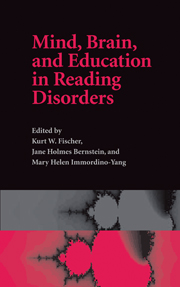Book contents
- Frontmatter
- Contents
- List of figures
- List of tables
- List of contributors
- Acknowledgements
- Part I What is Reading, and What are Reading Disorders? Looking to Neuroscience, Evolution, and Genetics
- Part II Reading and the Growing Brain: Methodology and History
- 4 A brief history of time, phonology, and other explanations of developmental dyslexia
- 5 Approaches to behavioral and neurological research on learning disabilities: in search of a deeper synthesis
- 6 Growth cycles of mind and brain: analyzing developmental pathways of learning disorders
- Essay: Cycles and gradients in development of the cortex
- 7 Brain bases of reading disabilities
- 8 The neural correlates of reading disorder: functional magnetic resonance imaging
- 9 Patterns of cortical connection in children with learning problems
- Essay: The role of experience in brain development: adverse effects of childhood maltreatment
- Part III Watching Children Read
- Part IV Reading Skills in the Long Term
- Appendix: Transcript and behavioral data from Profiles in Reading Skills (Four Boys)
- Index
- References
7 - Brain bases of reading disabilities
Published online by Cambridge University Press: 22 September 2009
- Frontmatter
- Contents
- List of figures
- List of tables
- List of contributors
- Acknowledgements
- Part I What is Reading, and What are Reading Disorders? Looking to Neuroscience, Evolution, and Genetics
- Part II Reading and the Growing Brain: Methodology and History
- 4 A brief history of time, phonology, and other explanations of developmental dyslexia
- 5 Approaches to behavioral and neurological research on learning disabilities: in search of a deeper synthesis
- 6 Growth cycles of mind and brain: analyzing developmental pathways of learning disorders
- Essay: Cycles and gradients in development of the cortex
- 7 Brain bases of reading disabilities
- 8 The neural correlates of reading disorder: functional magnetic resonance imaging
- 9 Patterns of cortical connection in children with learning problems
- Essay: The role of experience in brain development: adverse effects of childhood maltreatment
- Part III Watching Children Read
- Part IV Reading Skills in the Long Term
- Appendix: Transcript and behavioral data from Profiles in Reading Skills (Four Boys)
- Index
- References
Summary
Overview: For a century and a half, brain–behavior correlates in language were studied via the lesion approach, in which functional deficits after localized neurological damage are used to deduce the brain's organization. While much of the basic information gleaned from this research tradition still holds and new lesion-based discoveries continue to be made, modern advances with in vivo imaging techniques reveal that language processing in fact recruits many brain areas. In particular, different aspects of spoken and written language, such as orthography and semantics, require different kinds of neuropsychological processing. Given the complex distribution of language-related skills in the brain, the heterogeneity of dyslexic profiles is not surprising. In the end, it is likely that this very heterogeneity will prove key not just to unlocking the true nature of dyslexia but to understanding better the spoken and written language systems themselves.
The EditorsSince the late 1800s, scientists have known that there are specialized brain areas crucially involved in language reception and production, including understanding and producing written language. Reading impairments associated with a condition termed ‘visual word blindness’ were independently reported at the end of the nineteenth century by Scottish ophthalmologist James Hinshelwood and British physician Pringle Morgan (Hinshelwood 1895; Morgan 1896). These are generally considered the first behavioral accounts of the syndrome now called dyslexia. In the 1890s, based on lesion data collected by Monsieur Dejerine in adults, the left inferior parieto-occipital region along with the posterior section of the corpus callosum, called the splenium, were implicated as brain regions playing a special role in this disorder.
- Type
- Chapter
- Information
- Mind, Brain, and Education in Reading Disorders , pp. 133 - 147Publisher: Cambridge University PressPrint publication year: 2007



